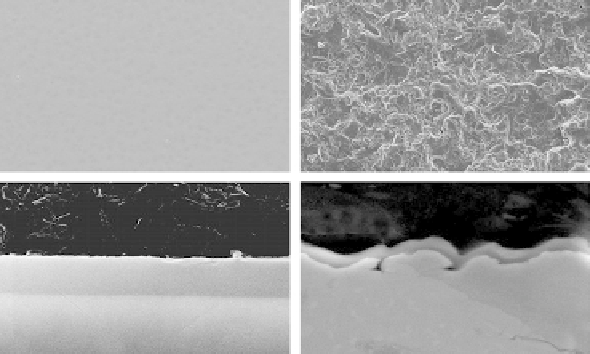Biomedical Engineering Reference
In-Depth Information
Magnetic field lines
Electric field
Electron
trajectory
E
Sputtered
area
B
S
Target
N
Permanent
magnet
FIGURE 7.8
Schematic illustration of magnetron and target.
RF magnetron sputtering is promising for bioceramic coating of metallic biomaterials
because highly adhered Ca-P-O coatings can be prepared uniformly at low temperature.
Figure 7.9 shows the appearance of amorphous calcium phosphate (ACP) coatings on mirror-
polished commercially pure (CP) Ti and blasted Ti-6Al-4V alloy substrates prepared by
RF magnetron sputtering. The surface feature of the coating well preserved the original
roughness of the blasted Ti-6Al-4V alloy substrate, proving good step-coverage even on
a complicated rough surface. Thermal spraying would not usually maintain the surface
roughness of the original substrate after application of a thick calcium phosphate coating,
while RF magnetron sputtering can achieve thin coatings with good adherence and cover-
age. Some studies on calcium phosphate coating on metallic biomaterials prepared by RF
magnetron sputtering have been reported.
(13-15,31-38)
The crystallinity of calcium phosphate
coating prepared by RF magnetron sputtering changed depending on process parameters
such as RF power, gas pressure in the sputtering chamber, and oxygen gas concentration.
Figure 7.10 depicts the effects of RF power and total gas pressure in the chamber on the
phase of calcium phosphate coating prepared at room temperature without the addition of
On mirror-polished CP Ti
On blasted Ti-6Al-4V
Surface
20 µm
50 µm
Resin
Coating
Resin
Cross
section
Coating
Ti-6Al-4V
CP Ti
1 µm
5 µm
FIGURE 7.9
SEM images of surface and cross section of ACP coatings prepared by RF magnetron sputtering.

































Search WWH ::

Custom Search